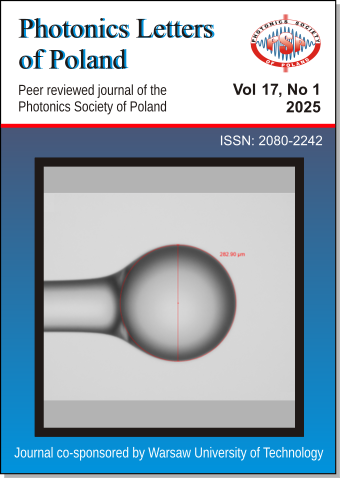Ratiometric optical laser power sensor based on polymer luminescent nanocomposite
DOI:
https://doi.org/10.4302/plp.v17i1.1323Abstract
The fabrication of nanocomposite photonic materials suggests their use in a wide variety of applications. An essential requirement for such materials is their photostability and high photobleaching resistance. Both lanthanides and quantum dots are good candidates for embedding in the polymer matrix to obtain highly luminescent nanocomposites. This paper presents the concept for the ratiometric optical pulsed laser power sensor based on terbium and red-emitting semiconductor quantum dots co-doped polymer luminescent nanocomposite for application in inexpensive laser monitoring systems.
Full Text: PDF
References
- P. Singh, S. Kachhap, P. Singh, S.K. Singh, "Lanthanide-based hybrid nanostructures: Classification, synthesis, optical properties, and multifunctional applications", Coord. Chem. Rev. 472, 214795 (2022). CrossRef
- X. Peng, Z. Wu, C. Ye, Y. Ding, W. Liu, "Analysis of the Emission Features in CdSe/ZnS Quantum Dot-Doped Polymer Fibers", Photonics 10(3), 327 (2023). CrossRef
- J.-C.G. Bünzli, "Lanthanide Photonics: Shaping the Nanoworld", Trends Chem. 1(8), 751 (2019). CrossRef
- A.K. Singh, "Multifunctionality of lanthanide-based luminescent hybrid materials", Coord. Chem. Rev. 455, 214365 (2022). CrossRef
- O.A. Goryacheva, N.V. Beloglazova, A.M. Vostrikova, M.V. Pozharov, A.M. Sobolev et al., Talanta 164, 377 (2017). CrossRef
- Lanthanide-to-quantum dot Förster resonance energy transfer (FRET): Application for immunoassay CrossRef
- M. Cardoso Dos Santos, N. Hildebrandt, "Recent developments in lanthanide-to-quantum dot FRET using time-gated fluorescence detection and photon upconversion", Trends Anal. Chem. 84, 60 (2016). CrossRef
- M. Valledor, J.C. Campo, F. Ferrero, I. Sánchez-Barragán, J.M. Costa-Fernández, A. Sanz-Medel, "A critical comparison between two different ratiometric techniques for optical luminescence sensing", Sens. Actuators B Chem. 139(1), 237 (2009). CrossRef
- A.P. Demchenko, "Dual emission and its λ-ratiometric detection in analytical fluorimetry. Pt. I. Basic mechanisms of generating the reporter signal", Methods Appl. Fluoresc. 11(3), 033002 (2023). CrossRef
- J. Zhou, B. Del Rosal, D. Jaque, S. Uchiyama, D. Jin, "Advances and challenges for fluorescence nanothermometry", Nat. Methods 17(10), 967 (2020). CrossRef
- Y. Hu, F. Xie, Q. Liu, N. Wang, J. Zhang et al., "Microfabricated sensor device for CW and pulsed laser power measurements", Opt. Expr. 31(2), 2330 (2023). CrossRef
- V. Askirka, V. Stsiapura, P. Miluski, "Efficient FRET in new co-doped Tb(tmhd)3-CdSe/ZnS quantum dots-poly (methyl methacrylate) polymer nanocomposites for optoelectronic and sensor applications", J. Lumin. 279, 121047 (2025). CrossRef
- P. Miluski, M. Kochanowicz, J. Zmojda, A. Baranowska, D. Dorosz, "Energy transfer of Tb(tmhd)3 - Rhodamine B in poly(methyl methacrylate) fiber for new photonic applications", Opt. Mater. 87, 132 (2019). CrossRef
- M. Cardoso Dos Santos, W.R. Algar, I.L. Medintz, N. Hildebrandt, "Quantum dots for Förster Resonance Energy Transfer (FRET)", Trends Anal. Chem. 125, 115819 (2020). CrossRef
Downloads
Published
How to Cite
Issue
Section
License
Copyright (c) 2025 Valiantsin Askirka

This work is licensed under a Creative Commons Attribution 4.0 International License.
Authors retain copyright and grant the journal right of first publication with the work simultaneously licensed under a Creative Commons Attribution License that allows others to share the work with an acknowledgement of the work's authorship and initial publication in this journal. Authors are able to enter into separate, additional contractual arrangements for the non-exclusive distribution of the journal's published version of the work (e.g., post it to an institutional repository or publish it in a book), with an acknowledgement of its initial publication in this journal. Authors are permitted and encouraged to post their work online (e.g., in institutional repositories or on their website) prior to and during the submission process, as it can lead to productive exchanges, as well as earlier and greater citation of published work (See The Effect of Open Access).




